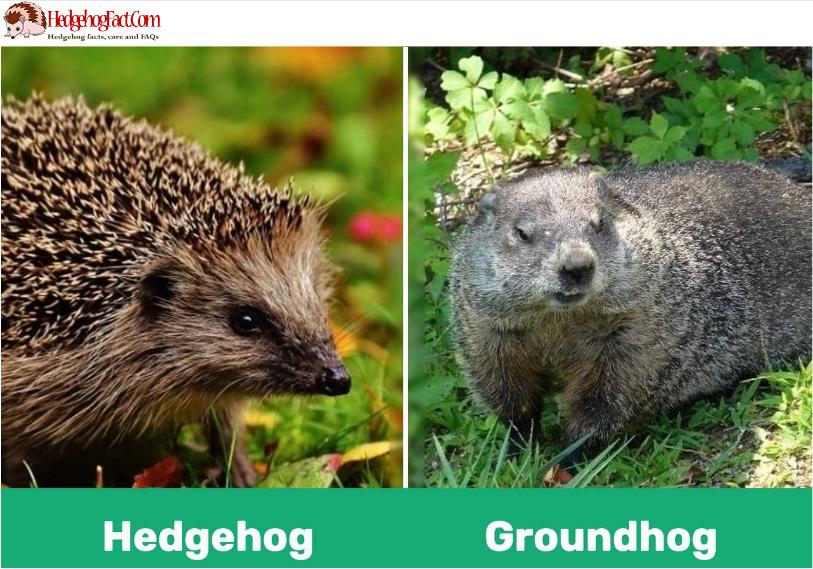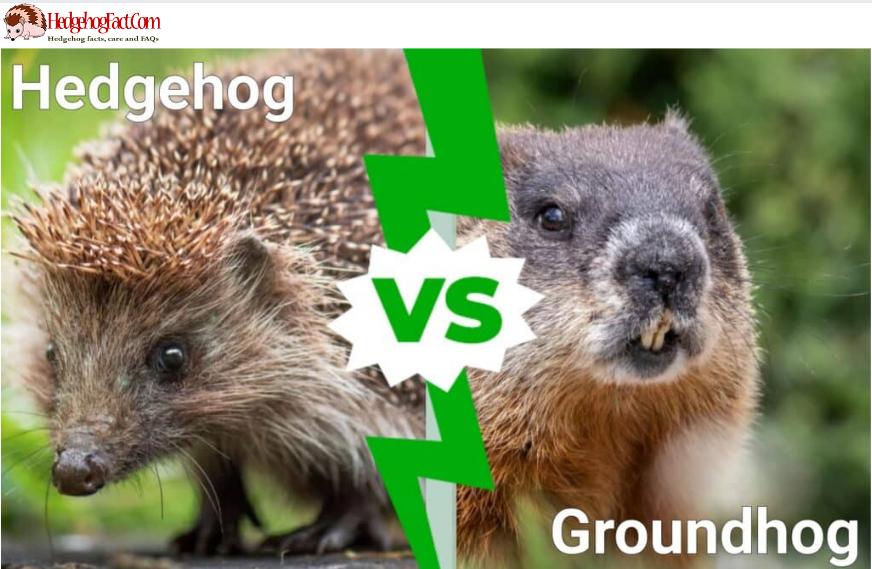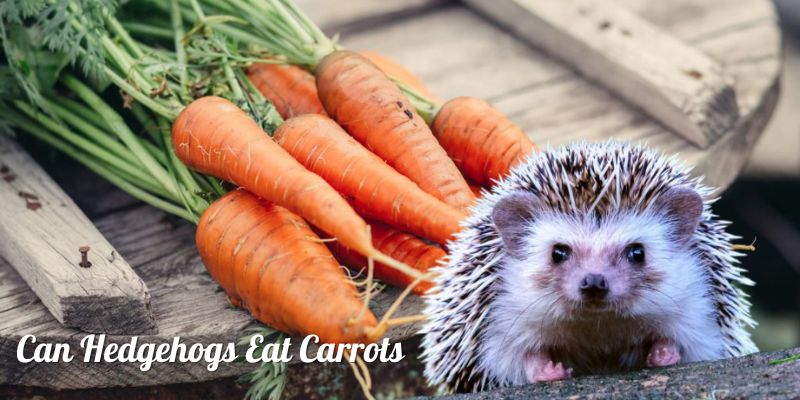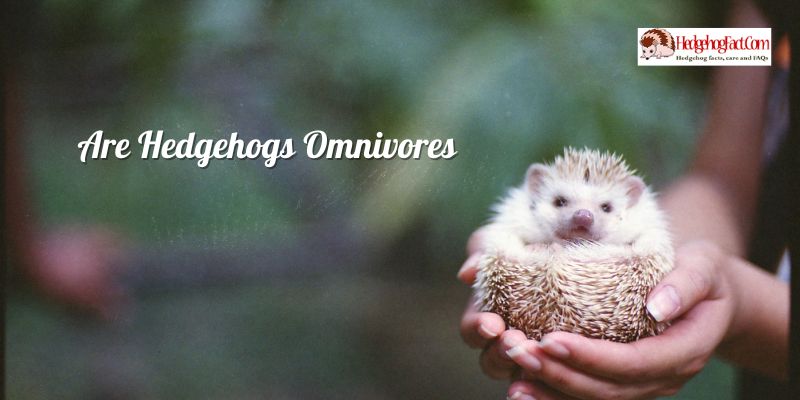Hedgehogs and groundhogs are both small animals that are often confused with one another. Although they share some similarities, there are significant differences between the two. In Hedgehog vs Groundhog: What are the differences?, Hedgehogfact.com will discuss the physical and behavioral differences between hedgehogs and groundhogs, their habitats, and their diets.
Physical Differences
Size
The morphological differences between groundhogs and hedgehogs, which are members of separate animal groups, help to distinguish them from one another. One of the most obvious distinctions between these two species, as you pointed out, is their size.
Hedgehogs are substantially smaller than groundhogs, which are members of the squirrel family and also known as woodchucks. They often have short legs, a bushy tail, and a stocky body. Groundhogs are notorious for their burrowing behavior, which can harm gardens and other locations. They are mostly herbivores.

Hedgehogs, on the other hand, belong to the Erinaceidae family and are much smaller. They feature a pointed snout, small legs, and a spherical body covered with spines. Hedgehogs, which predominately eat insects, are renowned for their capacity to ball up tightly to protect themselves. The gentle and adorable appearance of hedgehogs makes them popular pets.
Ultimately, despite the fact that both animals have the word “hog” in their names, they are each distinctive because to their highly different physical and behavioral traits.
Color
Although they do have a thick overcoat of gray fur, groundhogs’ overall colors can change based on the time of year and the individual. They frequently have a lighter-colored tummy, and their fur can range in color from dark brown to reddish brown.
On the other hand, hedgehogs don’t often look like salt and pepper. Instead, they typically have a speckled or banded pattern on their spines, which are a mixture of brown and white or cream. Hedgehog species that have black or white spines include the African Pygmy Hedgehog.
Hedgehogs are also widespread throughout the world, including Africa and Asia, while being more frequent in Europe. While native to North America, groundhogs can also be found in some areas of Canada. Hedgehogs and groundhogs both have distinctive and distinctive colorations, which can change based on the person and their environment.
Tail
Like other squirrel family members, groundhogs have a somewhat long tail that they can use for communication and balance. Depending on the person, their tail can be anywhere between 7 and 9.75 inches long.
Hedgehogs, in comparison, typically have tails that are less than an inch long. Its tail is not employed for balance or communication like a groundhog’s tail because it is frequently buried by their spines. Instead, hedgehogs defend themselves by curling tightly into a ball when threatened and relying on their spines.
So, the length of each animal’s tail differs from the other, which is another physical distinction.
Habitats
Geographic Distribution
In fact, groundhogs are native to North America, and they may be found in large portions of the eastern, central, and even certain sections of Canada. They are also called whistle-pigs or woodchucks.
On the other hand, hedgehogs are widespread around the planet and may be found in places like Asia, Africa, Europe, and New Zealand. Each region may have a different species of hedgehog, and some species are exclusive to a particular area.

For instance, the African pygmy hedgehog is found in some parts of Africa and is also sometimes kept as a pet. The European hedgehog is distributed over much of Europe. Hedgehogs are distributed all over the world, while groundhogs are mainly found in North America. Both species have distinctive ranges and habitats.
Habitat Preferences
Groundhogs are largely ground-dwelling creatures that are renowned for their capacity to create intricate underground tunnel networks. Several chambers, including spaces for sleeping, nesting, and hibernation, can be found in their burrows. Despite spending the most of their time on the ground, groundhogs are noted for being able to climb trees and other buildings.
Contrarily, hedgehogs occasionally use natural cavities for shelter, such as hollow logs or areas under plants, instead of digging tunnels. They may also use grass, leaves, and other items to construct nests above ground. Although they are often less skilled climbers than groundhogs, hedgehogs are more prone to look for cover in hedgerows, bushes, and other types of vegetation.
So, despite the fact that both groundhogs and hedgehogs may use underground or above-ground shelters for safety, their unique means of obtaining shelter as well as their habitats vary.
Behavioral Differences
Lifespan
Although they can live up to six years in captivity, groundhogs in the wild only have an average lifespan of about two to three years. Predation, illness, and habitat loss are just a few of the dangers that groundhogs encounter in the wild, all of which can shorten their lives.
Hedgehogs, on the other hand, normally live 3-5 years in the wild, however with the right care, they can live even longer in captivity. Hedgehogs, like groundhogs, are subject to a number of dangers in the wild, such as habitat degradation, car accidents, and pet predation.

In the wild, groundhogs and hedgehogs both have brief lifespans, with groundhogs often surviving a little longer than hedgehogs. Nevertheless, depending on the habitat, diet, and other environmental conditions, a groundhog’s or hedgehog’s lifespan might vary.
Diet
Groundhogs eat a range of plant materials, including grass, leaves, flowers, and occasionally bark and twigs. They are mostly herbivores. It is well known that they particularly enjoy clover and alfalfa. Although groundhogs primarily consume plants, they occasionally take insects or other small creatures for a meal.
While eating a range of insects and other small invertebrates including spiders, snails, and worms, hedgehogs are mostly insectivores. They can locate their prey by using their long, pointed snout, and they can catch and consume insects with their sharp teeth. Hedgehogs may occasionally consume some plant food, such as fruits and berries, but the majority of their diet consists of animal protein.
Although hedgehogs and groundhogs are largely insectivorous and herbivorous, respectively, both have some degree of dietary flexibility and may consume a variety of foods depending on their surroundings.
Mating and Reproduction
Normally, groundhogs only have one litter per year, and the breeding season starts in the late winter or early spring. After a gestation of about 31–32 days, the young are delivered, typically in April or May. Although litter sizes might range from 1 to 9, the average is about 4-5 young.
Contrarily, the breeding season for hedgehogs normally lasts from May to September, with the majority of breeding taking place in June and July. Hedgehogs have a gestation period of about 35 days, and females can give birth to litters of one to seven offspring, though three to four is most normal.
Hence, while both groundhogs and hedgehogs have breeding seasons that take place during the warmer months of the year and result in litters of young, the timing, frequency, and size of their litters can vary.
Conclusion
Overall, while hedgehogs and groundhogs may share some similarities, such as their small, burrowing nature and their ability to hibernate, they are distinct species with their own unique adaptations and behaviors.





